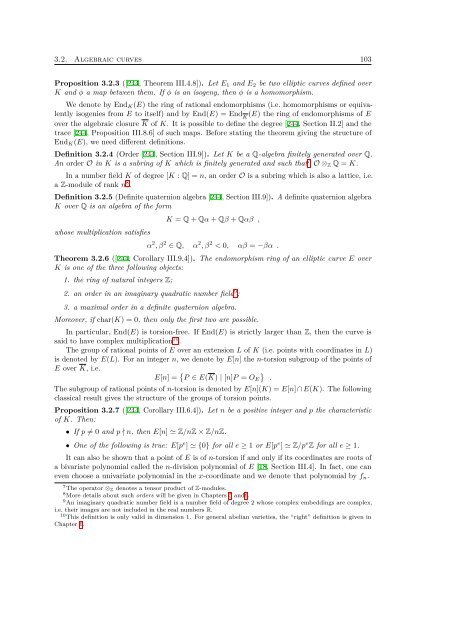here - Sites personnels de TELECOM ParisTech - Télécom ParisTech
here - Sites personnels de TELECOM ParisTech - Télécom ParisTech
here - Sites personnels de TELECOM ParisTech - Télécom ParisTech
Create successful ePaper yourself
Turn your PDF publications into a flip-book with our unique Google optimized e-Paper software.
3.2. Algebraic curves 103Proposition 3.2.3 ([244, Theorem III.4.8]). Let E 1 and E 2 be two elliptic curves <strong>de</strong>fined overK and φ a map between them. If φ is an isogeny, then φ is a homomorphism.We <strong>de</strong>note by End K (E) the ring of rational endomorphisms (i.e. homomorphisms or equivalentlyisogenies from E to itself) and by End(E) = End K(E) the ring of endomorphisms of Eover the algebraic closure K of K. It is possible to <strong>de</strong>fine the <strong>de</strong>gree [244, Section II.2] and thetrace [244, Proposition III.8.6] of such maps. Before stating the theorem giving the structure ofEnd K (E), we need different <strong>de</strong>finitions.Definition 3.2.4 (Or<strong>de</strong>r [244, Section III.9]). Let K be a Q-algebra finitely generated over Q.An or<strong>de</strong>r O in K is a subring of K which is finitely generated and such that 7 O ⊗ Z Q = K.In a number field K of <strong>de</strong>gree [K : Q] = n, an or<strong>de</strong>r O is a subring which is also a lattice, i.e.a Z-module of rank n 8 .Definition 3.2.5 (Definite quaternion algebra [244, Section III.9]). A <strong>de</strong>finite quaternion algebraK over Q is an algebra of the formwhose multiplication satisfiesK = Q + Qα + Qβ + Qαβ ,α 2 , β 2 ∈ Q, α 2 , β 2 < 0, αβ = −βα .Theorem 3.2.6 ([244, Corollary III.9.4]). The endomorphism ring of an elliptic curve E overK is one of the three following objects:1. the ring of natural integers Z;2. an or<strong>de</strong>r in an imaginary quadratic number field 9 ;3. a maximal or<strong>de</strong>r in a <strong>de</strong>finite quaternion algebra.Moreover, if char(K) = 0, then only the first two are possible.In particular, End(E) is torsion-free. If End(E) is strictly larger than Z, then the curve issaid to have complex multiplication 10 .The group of rational points of E over an extension L of K (i.e. points with coordinates in L)is <strong>de</strong>noted by E(L). For an integer n, we <strong>de</strong>note by E[n] the n-torsion subgroup of the points ofE over K, i.e.E[n] = { P ∈ E(K) | [n]P = O E}.The subgroup of rational points of n-torsion is <strong>de</strong>noted by E[n](K) = E[n] ∩ E(K). The followingclassical result gives the structure of the groups of torsion points.Proposition 3.2.7 ([244, Corollary III.6.4]). Let n be a positive integer and p the characteristicof K. Then:• If p ≠ 0 and p ∤ n, then E[n] ≃ Z/nZ × Z/nZ.• One of the following is true: E[p e ] ≃ {0} for all e ≥ 1 or E[p e ] ≃ Z/p e Z for all e ≥ 1.It can also be shown that a point of E is of n-torsion if and only if its coordinates are roots ofa bivariate polynomial called the n-division polynomial of E [18, Section III.4]. In fact, one caneven choose a univariate polynomial in the x-coordinate and we <strong>de</strong>note that polynomial by f n .7 The operator ⊗ Z <strong>de</strong>notes a tensor product of Z-modules.8 More <strong>de</strong>tails about such or<strong>de</strong>rs will be given in Chapters 5 and6.9 An imaginary quadratic number field is a number field of <strong>de</strong>gree 2 whose complex embeddings are complex,i.e. their images are not inclu<strong>de</strong>d in the real numbers R.10 This <strong>de</strong>finition is only valid in dimension 1. For general abelian varieties, the “right” <strong>de</strong>finition is given inChapter 6.
















